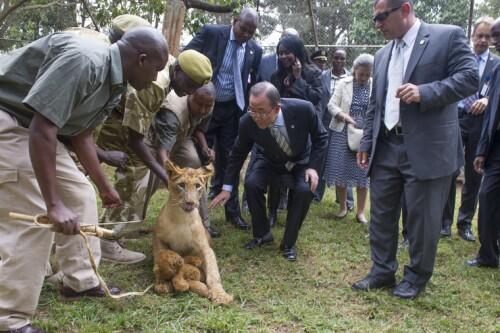Time is running out” to end wildlife poaching that threatens some of the world’s most iconic species, such as elephants, Secretary-General Ban Ki-moon said today as the United Nations marked World Wildlife Day.
Urging global efforts to protect this essential natural heritage for the current and future generations, much more needs to be done by key actors on all continents and across sectors, he said in a message, stressing that “the future of wildlife is in our hands,” echoing the theme of this year’s World Day.
“For too long, the world has been witness to heart-breaking images of the mass slaughter of elephants for their tusks,” he said.
According to the Secretariat of the Convention on International Trade in Endangered Species of Wild Fauna and Flora (CITES), the killing of African elephants and trafficking in their ivory remain alarmingly high. Asian elephants are also subject to growing levels of poaching. An estimate shows that about 100,000 elephants were slaughtered for their ivory between 2010 and 2012.
Under the theme, The future of wildlife is in our hands, African and Asian elephants are a main focus of the 2016 Day. Countries around the world are encouraged to highlight species of wild animals and plants from their own countries, adapting the global theme to suit.
Mr. Ban said that last year, UN Member States adopted the Sustainable Development Goals (SDGs), including specific targets to end poaching. The UN General Assembly also unanimously adopted a resolution to limit illicit trafficking in wildlife.
To combat poaching and trafficking of protected species, it is essential to address both the demand and supply of illegal wildlife products through agreed goals and targets and international instruments, such as the CITES, he added.
In his message, John E. Scanlon, CITES Secretary-General, noted that the current wildlife crisis is not a natural phenomenon, such as a drought, a flood or a cyclone. “It is the direct result of people’s actions,” he declared.
Across every continent, he noted, governments and citizens are tackling both demand and supply, making wildlife crime much riskier and far less profitable. “We are beginning to turn the tide on wildlife trafficking,” he said, adding, however, that much still remains to be done, and a collective success will rely upon the individual actions taken by each.
UN Environmental Programme (UNEP) Executive Director Achim Steiner said that the disappearance of individual species threatens biodiversity, and by extension, the life support systems on the planet. The Day is “a call to become more informed and more involved in stopping this crime against nature, communities and future generations,” he said.
Braulio F. de Souza Dias, Executive Secretary of the Convention on Biological Diversity, said wildlife is also the basis of biodiversity. Biodiversity in the wild is just as important to human wellbeing as biodiversity in plants and animals used for human consumption. Wildlife is incremental to forestry, fishery and tourism livelihoods around the world. Quite simply, biodiversity keep ecosystems functional providing the ecosystem services to allow people to survive, get enough food, and make a living.
“The conservation and sustainable use of wildlife is therefore a critical component of sustainable development, and should be part of a comprehensive approach to achieving poverty eradication, food security and sustainable livelihoods,” he said.
Source: UN News Center
















